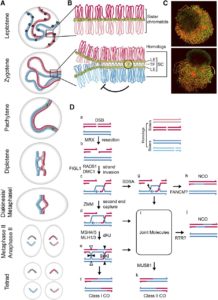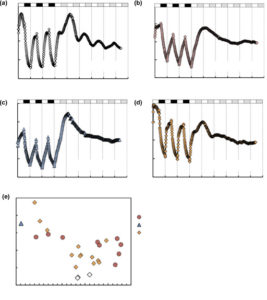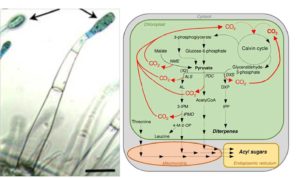Insights into Calmodulin-Interacting Proteins
 Calmodulin (CaM) and closely related CaM-like polypeptides are principal sensors of Ca2+ signals. The plant-specific IQ67 DOMAIN (IQD) family has emerged as possibly the largest class of CaM-interacting proteins with undefined molecular functions and biological roles. Bürstenbinder et al. (Plant Physiol. 173: 1692–1708) show that the 33 members of the IQD family in Arabidopsis differentially localize to multiple and distinct subcellular sites, including microtubule (MT) arrays, plasma membrane subdomains, and nuclear compartments. Intriguingly, the various IQD-specific localization patterns coincide with the subcellular patterns of IQD-dependent recruitment of CaM, suggesting that the diverse IQD members sequester Ca2+-CaM signaling modules to specific subcellular sites for precise regulation of Ca2+-dependent processes. Because MT localization is a hallmark of most IQD family members, the authors quantitatively analyzed GFP-labeled MT arrays in Nicotiana benthamiana cells transiently expressing GFP-IQD fusions and observed IQD-specific MT patterns, which point to a role of IQDs in MT organization and dynamics. Indeed, misexpression of select IQD proteins in Arabidopsis altered cellular MT orientation, cell shape, and organ morphology. Because IQDs share biochemical properties with scaffold proteins, the authors propose that the IQD family provides an assortment of platform proteins for integrating CaM-dependent Ca2+ signaling at multiple cellular sites to regulate cell function, shape, and growth.
Calmodulin (CaM) and closely related CaM-like polypeptides are principal sensors of Ca2+ signals. The plant-specific IQ67 DOMAIN (IQD) family has emerged as possibly the largest class of CaM-interacting proteins with undefined molecular functions and biological roles. Bürstenbinder et al. (Plant Physiol. 173: 1692–1708) show that the 33 members of the IQD family in Arabidopsis differentially localize to multiple and distinct subcellular sites, including microtubule (MT) arrays, plasma membrane subdomains, and nuclear compartments. Intriguingly, the various IQD-specific localization patterns coincide with the subcellular patterns of IQD-dependent recruitment of CaM, suggesting that the diverse IQD members sequester Ca2+-CaM signaling modules to specific subcellular sites for precise regulation of Ca2+-dependent processes. Because MT localization is a hallmark of most IQD family members, the authors quantitatively analyzed GFP-labeled MT arrays in Nicotiana benthamiana cells transiently expressing GFP-IQD fusions and observed IQD-specific MT patterns, which point to a role of IQDs in MT organization and dynamics. Indeed, misexpression of select IQD proteins in Arabidopsis altered cellular MT orientation, cell shape, and organ morphology. Because IQDs share biochemical properties with scaffold proteins, the authors propose that the IQD family provides an assortment of platform proteins for integrating CaM-dependent Ca2+ signaling at multiple cellular sites to regulate cell function, shape, and growth.


 Herbivory-induced plant cell wall modifications play an important role in deterring herbivory. Modified cell walls not only act as physical defenses against herbivores by enhancing the mechanical hardness of plant tissues but also reduce the digestibility of food for herbivores, thereby functioning as the first layer of defense against herbivores. In response, herbivores have evolved the capacity to suppress and circumvent these plant defenses through the release of effectors. Herbivores can secrete salivary plant cell wall-degrading enzymes such as cellulases (consisting of endo-β-1, 4-glucanases and β-glucosidases) and pectinases to degrade plant cell walls.
Herbivory-induced plant cell wall modifications play an important role in deterring herbivory. Modified cell walls not only act as physical defenses against herbivores by enhancing the mechanical hardness of plant tissues but also reduce the digestibility of food for herbivores, thereby functioning as the first layer of defense against herbivores. In response, herbivores have evolved the capacity to suppress and circumvent these plant defenses through the release of effectors. Herbivores can secrete salivary plant cell wall-degrading enzymes such as cellulases (consisting of endo-β-1, 4-glucanases and β-glucosidases) and pectinases to degrade plant cell walls. Meiosis is a specialized cell division, essential in most reproducing organisms to halve the number of chromosomes, thereby enabling the restoration of ploidy levels during fertilization. A key step of meiosis is homologous recombination, which promotes homologous pairing and generates crossovers (
Meiosis is a specialized cell division, essential in most reproducing organisms to halve the number of chromosomes, thereby enabling the restoration of ploidy levels during fertilization. A key step of meiosis is homologous recombination, which promotes homologous pairing and generates crossovers ( Transfer cells (TCs) play critical roles in membrane transport of solutes at various sites within plants and between plants and their environment. This transport capacity is conferred by inward wall protuberances that extend into the cell lumen. These ingrowths function to enhance the area of surrounding plasma membrane, therefore increasing surface-to-volume ratio of the TC and consequently promoting the transmembrane flux of solutes. Across the plant kingdom, the occurrence of TCs is proposed to be an indicator of anatomical locations where intensive transport occurs. In Arabidopsis (Arabidopsis thaliana), phloem parenchyma (PP) cells in the minor vein network of leaves and sepals can develop wall ingrowths to become PP TCs. Wall ingrowths in these PP TCs are typically bulky and predominantly abut sieve elements and to a lesser extent companion cells. PP TCs have been assumed to facilitate the efflux of photoassimilates.
Transfer cells (TCs) play critical roles in membrane transport of solutes at various sites within plants and between plants and their environment. This transport capacity is conferred by inward wall protuberances that extend into the cell lumen. These ingrowths function to enhance the area of surrounding plasma membrane, therefore increasing surface-to-volume ratio of the TC and consequently promoting the transmembrane flux of solutes. Across the plant kingdom, the occurrence of TCs is proposed to be an indicator of anatomical locations where intensive transport occurs. In Arabidopsis (Arabidopsis thaliana), phloem parenchyma (PP) cells in the minor vein network of leaves and sepals can develop wall ingrowths to become PP TCs. Wall ingrowths in these PP TCs are typically bulky and predominantly abut sieve elements and to a lesser extent companion cells. PP TCs have been assumed to facilitate the efflux of photoassimilates.  Clocks in green algae have been described as simple two-gene loops, while clocks in angiosperms have evolved to complex interlocked loops. This striking jump in complexity led Linde et al. to investigate the clocks in bryophytes and charophytes to shed light on this transition. First, through the sequence analysis of bryophyte’s and charophyte’s available genomes, the authors identified several homologues to the Arabidopsis clock genes, with some differences in copy number (duplication and loss) and presence. Then, they characterized the rhythmicity and functionality of such genes in mutants of the liverwort Marchantia polymorpha, as well as expression patterns in the former and the hornwort Anthoceros agrestis. Although we still don’t know what processes these clock genes control in bryophytes and charophytes, the results suggest an early occurrence of a complex circadian network that was present before or concurrent with the colonization of land by plants. (Summary by
Clocks in green algae have been described as simple two-gene loops, while clocks in angiosperms have evolved to complex interlocked loops. This striking jump in complexity led Linde et al. to investigate the clocks in bryophytes and charophytes to shed light on this transition. First, through the sequence analysis of bryophyte’s and charophyte’s available genomes, the authors identified several homologues to the Arabidopsis clock genes, with some differences in copy number (duplication and loss) and presence. Then, they characterized the rhythmicity and functionality of such genes in mutants of the liverwort Marchantia polymorpha, as well as expression patterns in the former and the hornwort Anthoceros agrestis. Although we still don’t know what processes these clock genes control in bryophytes and charophytes, the results suggest an early occurrence of a complex circadian network that was present before or concurrent with the colonization of land by plants. (Summary by  Drought tolerance is a complex trait, and Avramova et al. show that there is more than one way to be drought tolerant. Specifically, they investigate the role of antioxidants in supporting leaf growth in several varieties of drought tolerant maize. As compared to the tolerant lines, drought sensitive varieties accumulate more reactive oxygen species, including H2O2 and malondialdehyde (MDA: a marker for lipid peroxidation) in the leaf growth zone. Interestingly though, in some of the lines (specifically, those obtained from Egypt) drought tolerance was correlated with elevated levels of antioxidant metabolites, whereas in the other lines (from Europe and South Africa) drought tolerance was correlated with elevated activities of antioxidant enzymes. These results demonstrate that drought tolerance is associated with preventing the accumulation of reactive oxygen species, but that there is more than one way to achieve it. Frontiers Plant Sci.
Drought tolerance is a complex trait, and Avramova et al. show that there is more than one way to be drought tolerant. Specifically, they investigate the role of antioxidants in supporting leaf growth in several varieties of drought tolerant maize. As compared to the tolerant lines, drought sensitive varieties accumulate more reactive oxygen species, including H2O2 and malondialdehyde (MDA: a marker for lipid peroxidation) in the leaf growth zone. Interestingly though, in some of the lines (specifically, those obtained from Egypt) drought tolerance was correlated with elevated levels of antioxidant metabolites, whereas in the other lines (from Europe and South Africa) drought tolerance was correlated with elevated activities of antioxidant enzymes. These results demonstrate that drought tolerance is associated with preventing the accumulation of reactive oxygen species, but that there is more than one way to achieve it. Frontiers Plant Sci.  Rubisco (Ribulose-1,5-biphosphate carboxylase/oxygenase) is the key enzyme in photosynthetic carbon fixation. In C3 plants, the enzyme is usually found in mesophyll cells and guard cells, but it also can be found in photosynthetic glandular trichomes such as those found in tobacco. Laterre et al. used comparative proteomics to identify proteins specifically expressed in glandular trichomes. One of those they identified is a Rubisco small subunit protein, NtRbcS-T, which clusters with a distinct subset of RbcS subunits identified from other plants with secretory trichomes. Rubisco complexes incorporating the trichome subunits also show biochemical differences, including altered kinetics and pH dependency. The authors propose that this enzyme may be optimized for the distinctive cellular environment of glandular trichomes arising from the production of specialized metabolites. Plant Physiol.
Rubisco (Ribulose-1,5-biphosphate carboxylase/oxygenase) is the key enzyme in photosynthetic carbon fixation. In C3 plants, the enzyme is usually found in mesophyll cells and guard cells, but it also can be found in photosynthetic glandular trichomes such as those found in tobacco. Laterre et al. used comparative proteomics to identify proteins specifically expressed in glandular trichomes. One of those they identified is a Rubisco small subunit protein, NtRbcS-T, which clusters with a distinct subset of RbcS subunits identified from other plants with secretory trichomes. Rubisco complexes incorporating the trichome subunits also show biochemical differences, including altered kinetics and pH dependency. The authors propose that this enzyme may be optimized for the distinctive cellular environment of glandular trichomes arising from the production of specialized metabolites. Plant Physiol.  Flowering at the right time of year is crucial for plant reproductive success, so in many plants the transition to reproductive growth is sensitive to daylength. In recent years, the daylength-responsive signal that moves from leaves to the shoot apical meristem, florigen (encoded by FLOWERING LOCUS T (FT) in Arabidopsis), has been identified, but questions about its transport remain. Song et al. used CRISPR/Cas to mutagenize OsFTIP1, the rice orthologue of FT-INTERACTING PROTEIN 1, demonstrating its requirement for the movement of RICE FLOWERING LOCUS T (RFT) from companion cells to sieve elements and subsequent transport to the shoot apical meristem. The authors also show that the abundance of OsFTIP1 in leaves is regulated by proteolysis. Plant Cell
Flowering at the right time of year is crucial for plant reproductive success, so in many plants the transition to reproductive growth is sensitive to daylength. In recent years, the daylength-responsive signal that moves from leaves to the shoot apical meristem, florigen (encoded by FLOWERING LOCUS T (FT) in Arabidopsis), has been identified, but questions about its transport remain. Song et al. used CRISPR/Cas to mutagenize OsFTIP1, the rice orthologue of FT-INTERACTING PROTEIN 1, demonstrating its requirement for the movement of RICE FLOWERING LOCUS T (RFT) from companion cells to sieve elements and subsequent transport to the shoot apical meristem. The authors also show that the abundance of OsFTIP1 in leaves is regulated by proteolysis. Plant Cell